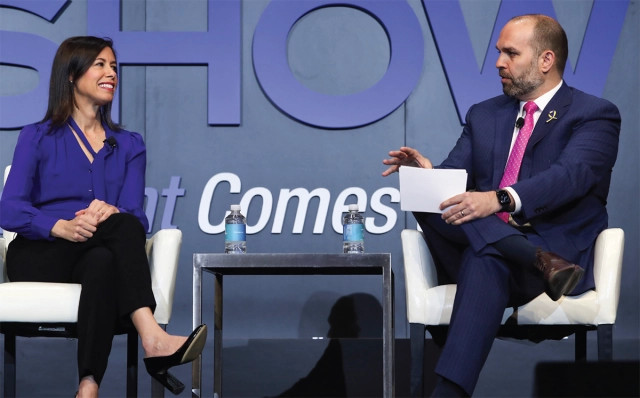
With its long hiatus in the rearview mirror, the NAB Show returned in April to Las Vegas, conveying an upbeat feel and a sense that things are returning to normal—or, at least a new normal where COVID is just an inconvenient part of life. (One need look no further than the COVID testing stations at the LVCC and the proof-of-vaccination/negative-COVID-test admittance policy for evidence of that.)
As is tradition, the president and CEO of NAB and chairperson of the FCC held a fireside chat at the start of the show—the first time for both Curtis LeGeyt, who took charge of the association in January, and Jessica Rosenworcel, whom the Senate confirmed as chairperson in December.
Regarding ATSC 3.0, Rosenworcel made four important points broadcasters would be wise to consider:
- The FCC chairperson recognizes the need for special temporary authorities to address 3.0 “bumps in the road” and commended Media Bureau Chief Holly Saurer for “sitting down with any broadcaster who comes in and says, ‘You know, I’ve got a problem with my 3.0 signal in the way I need to work in my marketplace’” and making sure broadcasters have the “space to experiment and innovate.”
- Rosenworcel acknowledges that rule changes may be necessary to advance 3.0 and expressed a willingness to work with broadcasters on finding solutions. Pointing to those who have sought rule changes to address 3.0 and multicasting as an example, she told broadcasters to “come to us, tell us what you’re seeing. Tell us what’s working and where there might be a hurdle in our rules that we should figure out how to fix.”
- The chairperson views current period with 3.0 as an “experimental” phase. Referring to the FCC’s “framework” for NextGen TV in which 1.0 continues and broadcasters voluntarily work together to put 3.0 on air in local markets, she said, “…[W]hat that does is it gives broadcasters the opportunity to experiment with this technology, develop use cases, try to figure out what services work at scale.”
- Rosenworcel also wishes to deal with the inherent incompatibility of 3.0 and 1.0. “You know, the standard is still not backwards-compatible with existing receivers and televisions, and that’s going to be something we need to address.”
From where I sit, these are the important takeaways from the fireside chat. Rosenworcel gets high marks for expressing the agency’s desire to work with broadcasters on STAs and rule changes needed to advance NextGen TV deployment.
The broadcast industry needs to do a better job of conveying where it is with the 3.0 rollout. In my mind—and likely the minds of the consumer electronics manufacturers onboard the NextGen TV bandwagon with 100 or more 3.0 models, the industry is transitioning, or has transitioned, from the “experimental” phase to deployment. The word “experiment” makes it seem like packing it in is a possibility.
Lastly, is backwards compatibility really on the table? I thought that was settled. If I were a pessimist, I might view that comment as a red flag that could be used as an excuse to extend the 1.0 sunset timeframe indefinitely or even as a reason to end the “experiment.” If I were an optimist, I could see it as a hint that someone in Washington is toying with the idea of a coupon program for 3.0-to-1.0 set-top boxes for all of those existing DTV households.
But I’m a realist, hoping for the latter, concerned about the former and, at the end of the day, cautiously thinking the chairperson may have misspoken or been jetlagged. Time will tell.
The professional video industry's #1 source for news, trends and product and tech information. Sign up below.
Phil Kurz is a contributing editor to TV Tech. He has written about TV and video technology for more than 30 years and served as editor of three leading industry magazines. He earned a Bachelor of Journalism and a Master’s Degree in Journalism from the University of Missouri-Columbia School of Journalism.

